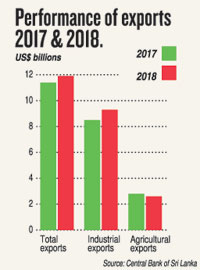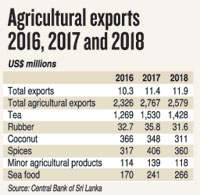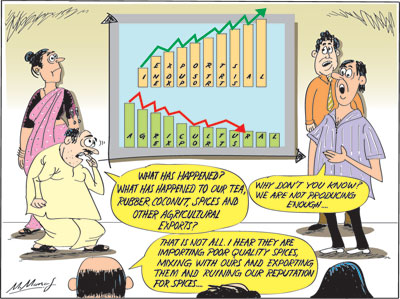Columns
Declining agricultural exports since 2018 serious economic concern
View(s): The recent decline in agricultural exports is a serious economic concern as it has an adverse impact on the country’s export earnings, trade balance, balance of payments and on economic growth. The decrease in agricultural exports has dragged down last year’s and this year’s noteworthy export growth. Expanding agricultural exports is crucial to improve the trade balance and balance of payments.
The recent decline in agricultural exports is a serious economic concern as it has an adverse impact on the country’s export earnings, trade balance, balance of payments and on economic growth. The decrease in agricultural exports has dragged down last year’s and this year’s noteworthy export growth. Expanding agricultural exports is crucial to improve the trade balance and balance of payments.
Total exports increased by 10.2 percent in 2017, by a further 4.7 percent in 2018 and increased by nearly 5 percent in the first six months of this year. Despite this recent export growth, agricultural exports fell by 6.8 percent last year and by a further 6 percent in the first half of this year, compared to the same period last year. This decrease in agricultural exports is a drag on the country’s external finances.
 Significance of agricultural exports
Significance of agricultural exports
Tea, rubber and coconut accounted for 94 percent of exports in 1950. Even in 1977 these three crops constituted 79 percent of total exports. That pattern has changed with the diversification of the economy in the 1980s after the liberalisation of the economy in 1977, when there was a significant diversification of the economy and of exports.
By 2000 agricultural exports declined to 20 percent of total exports and tea rubber and coconut exports amounted to only 17 percent of total exports. In 2018 total agricultural exports accounted for less than 17 percent of total exports. This diversification of the economy and exports is a favourable development. However, agricultural exports declined due to lower exportable surpluses owing to lower production, and, especially in the case of coconut, higher domestic consumption too. Tea production on estates and rubber production on estates and small holdings have been unsatisfactory.
This recent unsatisfactory performance of agricultural exports is worrying as all agricultural exports, with the exception of sea food exports, decreased in 2018 and in the first half of the year (See Table). This dismal export performance of all agricultural crops requires to be reversed to enhance exports. There is an international demand for most agricultural exports that cannot be met owing to inadequate production and quality issues.
 Tea
Tea
Tea has been the country’s main export from pre-independence times. Even today tea is the main agricultural export. Tea exports declined by as much as 6.6 percent in 2018 and by 6 percent in the first half of this year compared to the same period last year. This decrease is owing to both a decrease in the exportable surplus of tea and lower prices. Despite the declining importance of tea in total exports, it is the country’s main agricultural export and its value addition is higher than those of manufactured exports that have a high import content. Therefore it is important to increase productivity and production, especially on the tea plantations that have low yields owing to the senility of large extents of estate tea land, inadequate replanting and under planting and labour scarcity.
Rubber
Rubber exports declined owing to both a decrease in production and the use of most natural rubber produced in the country being used for manufactures, While rubber exports accounted for only US$ 31.6 million In 2018, rubber manufactures earned US$ 875 million. This use of natural rubber for manufactures is a favourable development. Had rubber production increased, it would have made a more significant contribution to the country’s export earnings. The effective implementation of the Rubber Master Plan to increase natural rubber production by expanding the area cultivated with rubber would contribute much to improving the trade balance.
 Coconut
Coconut
Export earnings from Coconut have diminished over the years. It amounted to only US$ 316 million in 2018: a dip of 11.3 percent from the export earnings of 2017. This declining trend in coconut exports is likely to continue as domestic consumption is increasing, while there is no commensurate increase in coconut production. While increasing the export surplus of coconut is unrealistic, coconut production should be increased to meet increasing domestic consumption needs. Otherwise there would be an adverse impact on the trade balance owing to an increase in edible oils.
Spices
Spice exports declined by 11.3 percent in 2018. There appears to be an alarming development in the export of spices. Sri Lanka’s reputation for high quality spices is being undermined by the mixing of low quality imports and exporting these as Sri Lankan products. This could harm the country’s reputation for high quality spices and ruin spice exports in the long run. The potential for increasing spice exports must not be frittered away as the revival of spice exports is of importance for the country’s export earnings.
Summary
Despite a trend of increasing total exports, agricultural exports fell by 6.8 percent in 2018 from US$ 2.8 billion in 2017 to 2.6 billion in 2018 and decreased by a further 6 percent compared to the same period last year. Earnings from all agricultural exports, except sea food exports, have decreased in 2018 and in the first half of this year. The country’s main agricultural export—tea—declined by as much as 6.6 percent last year and continued to decrease in the first half of this year. Decreased production of tea has been mainly responsible for this, though lower international prices have also been a factor. The reduction in spice exports is an unacceptable feature of the country’s export performance.
The decrease in agricultural exports is a serious concern for the balance of trade and payments and economic growth. Had agricultural exports too increased, export growth would have been better and the trade deficit would have narrowed significantly. The only agricultural export that increased last year and in the first six months of this year was sea food. The fall in agricultural exports would have been more severe, if not for the significant growth in sea food exports in 2018 and in first half of this year. Despite the potential for the export of spices, cashew and other food crops, their export performance has been dismal.
Final word
The significance of agricultural exports is more than indicated by their export values as their import content is much lower than for manufactured exports. Increasing the country’s agricultural exports is vital to improve the trade balance and balance of payments. Enhancing the country’s agricultural exports is vital to improve the trade balances and strengthen the trade balance of payments. The declining trend in agricultural exports must be arrested to improve the trade balance. This is particularly so with respect to tea, spices and minor crop exports that have fallen.


Leave a Reply
Post Comment